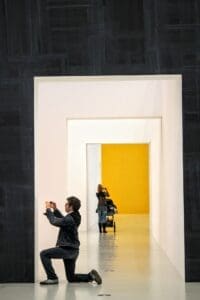Non-figurative abstraction begins with the imaginative power of humans. Clearly distinguishable from fantasy art, the form reflects reality in non-figurative expressions. In simpler words, non-figurative abstract art depicts real forms in rather a different way. Abstract art is not an outcome of the 20th century thinkers, contrary to popular belief. It also does not have a sudden origin. If we go back to the Islamic and Jewish religions, where depiction of human bodies was a definite no-no, then we can find a lot of calligraphy and non-figurative art forms. Let us even date back to the prehistoric times, where humans used symbols for fire, water or thunder, which are hard for a modern man to interpret. However, those prehistoric creations have an eternal appeal to the modern men, because of the intrinsic aesthetics. Therefore, we can take those depictions of our ancestors as work of abstraction.
What history says?
People regard Wassily Kandinsky as the father of abstract art. Though started with figurative work in 1910, he gradually moved out of it and concentrated on non-figurative forms. Painters like Kasimir Malewich followed his path and took the art form to another level. His paintings were mostly on simple geometric forms. Other artists following Kandinsky’s path were Paul Klee, Raoul Dufy, and Piet Mondrian. Piet Mondrian pioneered the first non-figurative abstract paintings.
In the middle of the 20th century, some landmark events totally changed the normal course of abstraction. The Jewish persecution by Hitler, the World War II, and admonition of modern art by the Nazis resulted in immigrant ultramodern European artists into the United States of America, in hundreds of numbers. This brought forward a fresh wave in the American art scenario, resulting in the birth of Abstract Expressionism.
Abstract Expressionism – What it is
Abstraction actually removes the reality in an object. The degree of removal varies from partial to complete. The image becomes a replica of the reality in its subtle form.
The term does not depict any style. It is rather a concept of performing art. The movement, consisting of famous artists like Mark Rothko, Willem de Kooning, and Jackson Pollock, pushed all the traditional boundaries beyond every limit. Mark Rothko introduced one segment of abstraction with unified blocks of color, popularly known as “Color Field Abstract Art”. The other segment included multiple genres like Cubism, Expressionism, Action painting, and Surrealism. However, the core of abstract work remains in depicting the subconscious of the artist on canvas.
Phenomenal wave created by the masters
Pablo Picasso, in the first decade of the twentieth century, created a new wave in the world of abstraction. It drastically changed the presentation, forms, and styles of creations and created a ripple of movements; affecting the works of poets, musicians, and authors all across the globe. Practice of Cubism by George Barque in his emotionally charged paintings with altered forms, colors, and shapes of Expressionism laid the plinth of abstraction. The form also gathered its inspiration from post-Impressionism artists like Gauguin, Vincent Van Gogh, and Cezanne. During the early twentieth century, Henry Matisse, along with his followers, introduced Fauvism. It concerned usage of raw colors.
What makes abstract art different?
The basic characteristic that differentiates abstract art from realism is the fluidity. This form represents things that lie beyond the visionary perception of human beings, like sound, emotion or spiritual experience. To quote Kandinsky, “ of all arts, abstract painting is the most difficult. It demands that you know to draw well, that you have a heightened sensitivity for composition and of colors, and that you are a true poet; this last is essential. ”
The future of abstract painting
With advent of newer tools and methodologies, there is a shift in style from the traditional ones like color field painting and action painting. Forms take different shapes, ideas become modern, and fresh thoughts arise. However, the basic idea behind abstraction remains the same. Non-figurative abstract art definitely has a colorful and bright future.





